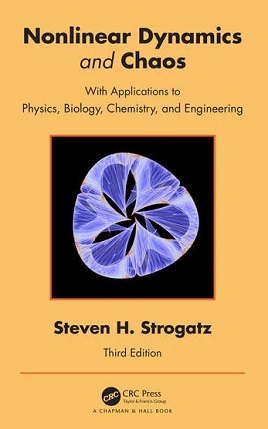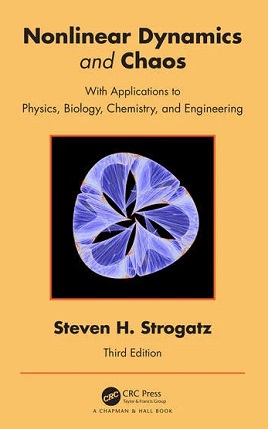Nonlinear Dynamics And Chaos
WestView Press
Edición: 3ª - 2024
-
Papel:
- ISBN: 9781032791654
- Idioma:Inglés
- Medidas:15.5 x 23
- Encuadernación: Rústica
- Páginas: 616
OFERTA!!
antes:
119,29 €ahora: 113,33 €
Agotado en editorial
Información detallada:
Resumen del libro
The goal of this third edition of Nonlinear Dynamics and Chaos: With Applications to Physics, Biology, Chemistry, and Engineering is the same as previous editions: to provide a good foundation - and a joyful experience - for anyone who’d like to learn about nonlinear dynamics and chaos from an applied perspective.
The presentation stresses analytical methods, concrete examples, and geometric intuition. The theory is developed systematically, starting with first-order differential equations and their bifurcations, followed by phase plane analysis, limit cycles and their bifurcations, and culminating with the Lorenz equations, chaos, iterated maps, period doubling, renormalization, fractals, and strange attractors.
The prerequisites are comfort with multivariable calculus and linear algebra, as well as a first course in physics. Ideas from probability, complex analysis, and Fourier analysis are invoked, but they're either worked out from scratch or can be safely skipped (or accepted on faith).
Changes to this edition include substantial exercises about conceptual models of climate change, an updated treatment of the SIR model of epidemics, and amendments (based on recent research) about the Selkov model of oscillatory glycolysis. Equations, diagrams, and every word has been reconsidered and often revised. There are also about 50 new references, many of them from the recent literature.
The most notable change is a new chapter. Chapter 13 is about the Kuramoto model.
The Kuramoto model is an icon of nonlinear dynamics. Introduced in 1975 by the Japanese physicist Yoshiki Kuramoto, his elegant model is one of the rare examples of a high-dimensional nonlinear system that can be solved by elementary means.
Students and teachers have embraced the book in the past, its general approach and framework continue to be sound.
Índice
Chapter 1 Overview
1.0 Chaos, Fractals, and Dynamics
1.1 Capsule History of Dynamics
1.2 The Importance of Being Nonlinear
1.3 A Dynamical View of the World
Part I One-Dimensional Flows
Chapter 2 Flows on the Line
2.0 Introduction
2.1 A Geometric Way of Thinking
2.2 Fixed Points and Stability
2.3 Population Growth
2.4 Linear Stability Analysis
2.5 Existence and Uniqueness
2.6 Impossibility of Oscillations
2.7 Potentials
2.8 Solving Equations on the Computer
Exercises for Chapter 2
Chapter 3 Bifurcations
3.0 Introduction
3.1 Saddle-Node Bifurcation
3.2 Transcritical Bifurcation
3.3 Laser Threshold
3.4 Pitchfork Bifurcation
3.5 Overdamped Bead on a Rotating Hoop
3.6 Imperfect Bifurcations and Catastrophes
3.7 Insect Outbreak
Exercises for Chapter 3
Chapter 4 Flows on the Circle
4.0 Introduction
4.1 Examples and Definitions
4.2 Uniform Oscillator
4.3 Nonuniform Oscillator
4.4 Overdamped Pendulum
4.5 Fireflies
4.6 Superconducting Josephson Junctions
Exercises for Chapter 4
Part II Two-Dimensional Flows
Chapter 5 Linear Systems
5.0 Introduction
5.1 Definitions and Examples
5.2 Classification of Linear Systems
5.3 Love Affairs
Exercises for Chapter 5
Chapter 6 Phase Plane
6.0 Introduction
6.1 Phase Portraits
6.2 Existence, Uniqueness, and Topological Consequences
6.3 Fixed Points and Linearization
6.4 Rabbits versus Sheep
6.5 Conservative Systems
6.6 Reversible Systems
6.7 Pendulum
6.8 Index Theory
Exercises for Chapter 6
Chapter 7 Limit Cycles
7.0 Introduction
7.1 Examples
7.2 Ruling Out Closed Orbits
7.3 Poincaré−Bendixson Theorem
7.4 Liénard Systems
7.5 Relaxation Oscillations
7.6 Weakly Nonlinear Oscillators
Exercises for Chapter 7
Chapter 8 Bifurcations Revisited
8.0 Introduction
8.1 Saddle-Node, Transcritical, and Pitchfork Bifurcations
8.2 Hopf Bifurcations
8.3 Oscillating Chemical Reactions
8.4 Global Bifurcations of Cycles
8.5 Hysteresis in the Driven Pendulum and Josephson Junction
8.6 Coupled Oscillators and Quasiperiodicity
8.7 Poincaré Maps
Exercises for Chapter 8
Part III Chaos
Chapter 9 Lorenz Equations
9.0 Introduction
9.1 A Chaotic Waterwheel
9.2 Simple Properties of the Lorenz Equations
9.3 Chaos on a Strange Attractor
9.4 Lorenz Map
9.5 Exploring Parameter Space
9.6 Using Chaos to Send Secret Messages
Exercises for Chapter 9
Chapter 10 One-Dimensional Maps
10.0 Introduction
10.1 Fixed Points and Cobwebs
10.2 Logistic Map: Numerics
10.3 Logistic Map: Analysis
10.4 Periodic Windows
10.5 Liapunov Exponent
10.6 Universality and Experiments
10.7 Renormalization
Exercises for Chapter 10
Chapter 11 Fractals
11.0 Introduction
11.1 Countable and Uncountable Sets
11.2 Cantor Set
11.3 Dimension of Self-Similar Fractals
11.4 Box Dimension
11.5 Pointwise and Correlation Dimensions
Exercises for Chapter 11
Chapter 12 Strange Attractors
12.0 Introduction
12.1 The Simplest Examples
12.2 Hénon Map
12.3 Rössler System
12.4 Chemical Chaos and Attractor Reconstruction
12.5 Forced Double-Well Oscillator
Exercises for Chapter 12
Part IV Collective Behavior
Chapter 13 Kuramoto Model
13.0 Introduction
13.1 Governing Equations
13.2 Visualization and the Order Parameter
13.3 Mean-Field Coupling and Rotating Frame
13.4 Steady State
13.5 Self-Consistency
13.6 Remaining Questions
Exercises for Chapter 13
Otros libros de Steven H. Strogatz
-
<p>The goal of this third edition of <strong><em>Nonlinear Dynamics and Chaos: With Applications ...




